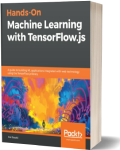Hands-On Machine Learning with TensorFlow.js
Artificial Intelligence
Book Details
Book Title
Hands-On Machine Learning with TensorFlow.js
Author
Kai Sasaki
Publisher
Packt Publishing
Publication Date
2019
ISBN
9781838821739
Number of Pages
285
Language
English
Format
File Size
5MB
Subject
Artificial Intelligence
Table of Contents
- Cover
- Title Page
- Copyright and Credits
- About Packt
- Contributors
- Table of Contents
- Preface
- Section 1: The Rationale of Machine Learning and the Usage of TensorFlow.js
- Chapter 1: Machine Learning for the Web
- Technical requirements
- Why machine learning on the web?
- Operation graphs
- What is TensorFlow.js?
- Installing TensorFlow.js
- The low-level API
- The Layers API
- Summary
- Questions
- Further reading
- Chapter 2: Importing Pretrained Models into TensorFlow.js
- Technical requirements
- The portable model format
- Exporting a model from TensorFlow
- Converting models using tfjs-converter
- Loading the model into TensorFlow.js
- Summary
- Questions
- Further reading
- Chapter 3: TensorFlow.js Ecosystem
- Technical requirements
- Why high-level libraries?
- Using existing models
- Loading the data from various kinds of storage
- Pose detection with ML5.js
- Drawing cats with Magenta.js
- XOR classification with machinelearn.js
- Summary
- Exercises
- Further reading
- Section 2: Real-World Applications of TensorFlow.js
- Chapter 4: Polynomial Regression
- Technical requirements
- What is polynomial regression?
- Two-dimensional curve fitting
- Summary
- Questions
- Further reading
- Chapter 5: Classification with Logistic Regression
- Technical requirements
- Background of binary classification
- What is logistic regression?
- Classifying two-dimensional clusters
- Summary
- Questions
- Further reading
- Chapter 6: Unsupervised Learning
- Technical requirements
- What is unsupervised learning?
- Learning how K-means works
- Generalizing K-means with the EM algorithm
- Clustering two groups in a 2D space
- Summary
- Exercise
- Further reading
- Chapter 7: Sequential Data Analysis
- Technical requirements
- What is Fourier transformation?
- Cosine curve decomposition
- Summary
- Exercise
- Further reading
- Chapter 8: Dimensionality Reduction
- Technical requirements
- Why dimensionality reduction?
- Understanding principal component analysis
- Projecting 3D points into a 2D space with PCA
- Word embedding
- Summary
- Exercise
- Further reading
- Chapter 9: Solving the Markov Decision Process
- Technical requirements
- Reinforcement learning
- Solving the four-states environment
- Summary
- Exercise
- Further reading
- Section 3: Productionizing Machine Learning Applications with TensorFlow.js
- Chapter 10: Deploying Machine Learning Applications
- Technical requirements
- The ecosystem around the JavaScript platform
- Module bundler
- Deploying modules with GitHub Pages
- Summary
- Questions
- Further reading
- Chapter 11: Tuning Applications to Achieve High Performance
- Technical requirements
- The backend API of TensorFlow.js
- Tensor management
- Asynchronous data access
- Profiling
- Model visualization
- Summary
- Questions
- Further reading
- Chapter 12: Future Work Around TensorFlow.js
- Technical requirements
- Experimental backend implementations
- AutoML edge helper
- Summary
- Questions
- Further Reading
- Other Books You May Enjoy
- Index
